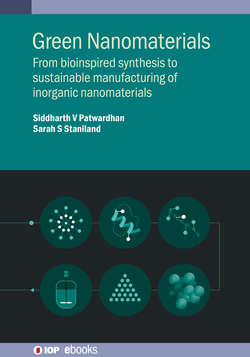Читать книгу Green Nanomaterials - Siddharth Patwardhan - Страница 5
На сайте Литреса книга снята с продажи.
ОглавлениеPreface
This book aims to provide an understanding of emerging bioinspired green methods for preparing inorganic nanomaterials.
Inorganic nanomaterials are used in many applications, ranging from sun cream to catalysis, as well as the latest innovations in nanomedicine and high density data storage. In recent years, we have understandably seen a large quantity of publication activity (including books) on the safety and toxicity of nanomaterials. However, there is a distinct lack of consolidated effort in addressing the sustainability of making nanomaterials. Current methods for nanomaterial synthesis are complex, energy demanding, multistep, and/or environmentally damaging, and hence clearly not sustainable. Green chemistry has great promise for future developments, particularly in sustainable designs for materials, processes, consumer goods, etc. However, to date, green chemistry has mostly focussed on the synthesis of fine chemicals and very rarely on nanomaterials.
New bioinspired/biomimetic approaches are emerging, which harness biological principles from biomineralisation to design green nanomaterials for the future. With reference to the significant body of research on understanding biomineralisation, Ozin et al state in their book, Nanochemistry: A Chemical Approach to Nanomaterials, that ‘In molecular terms, it is relatively easy to comprehend the early stages of self-organisation, molecular recognition, and nucleation that precede the morphogenesis of biomineral form. It is not obvious however, how complex shapes emerge and how, in turn, they can be copied synthetically’ [1]. In this book, the aim is to address this highly sought-after aspect of how to translate the understanding of biomineral synthesis into new green manufacturing methods. We cover areas from the discovery of new green synthesis methods all the way to considering their commercial manufacturing routes.
Who is the book for? The Royal Society of Chemistry and the American Chemical Society’s Green Chemistry Institute have both highlighted a ‘lack of a deep bench of scientists and engineers with experience in developing green nanotechnology’ [2] as a significant barrier to the development and commercialisation of green nanotechnology. This has motivated us to write this book. When any of us have been educated within a specific traditional discipline of science or engineering for our undergraduate degree, it can be very daunting to take a leap into multidisciplinary science and study within the realms of new disciplines outside our comfort zone, where the experimental approach, culture and even language can be so different, creating barriers and challenges. However, the more we work at this interface, the more we realise that these boundaries are artificial, for the purpose of our education, and do not exist in Nature. The purpose of this book is to start with basic explanations to build a foundation, so that this area of science can become accessible to students from any related discipline. We hope that this book encourages scientists and engineers to become confident in bridging the gaps between chemistry, nanotechnology, biology, engineering and manufacturing. Specifically, the book combines green chemistry and nanomaterials in a single dedicated monograph.
As such, the book is written with a wide readership in mind, including primarily academic researchers focusing on synthetic biology and nanomaterials. It is targeted towards postgraduate students (taught and research degrees) undertaking studies pertaining to advanced materials and green, sustainable and/or environmental engineering or chemistry. Final year undergraduate students specialising in nanomaterials or green processes will also find this book valuable. Indeed, various universities currently run final year electives on nanomaterials, biomaterials, green chemistry, sustainability, etc, where this book is highly suitable as a textbook. Through the authors’ interactions with industry, we know that many industries wish to learn more about these green technologies. Hence, we hope to reach industrialists and raise awareness of the emerging green manufacturing routes.
What is in the book? The book starts by introducing the principles of green chemistry and engineering (chapter 1). It then highlights the special properties that nanomaterials possess, their applications and ways of characterising them (chapters 2 and 3). It describes conventional methods of synthesising and manufacturing inorganic nanomaterials (chapter 4) and highlights that these techniques cannot always deliver the specifications required for applications or be sustainable (chapter 5). This will lead to the introduction of biological and biomimetic/bioinspired synthetic methods as a solution to precisely controlled nanomaterials as well as the design of sustainable manufacturing routes (chapters 6 and 7). The book elaborates on various mechanisms and examples of green nanomaterials (e.g. the role of an organic matrix and natural self-assembly, and advantages and opportunities with green nanomaterials). It will cover two case studies of magnetic and silica materials for advanced readers (chapters 8 and 9).
How to use the book. We acknowledge this book covers many different traditional disciplines and as such we cannot go into too much depth in every area. Furthermore, this is a very current and fast-moving research area. As new methods, materials and characterisation techniques are discovered, invented and developed, fairly recent advances become old quickly. For both reasons we recommend this textbook be supplemented with more detailed, specific and contemporary science and engineering research journal papers. Indeed, in the courses we teach on this subject, the material content of this book is used to explain the background and introduce current research papers as relevant examples.
A note on ongoing discussion on the topics covered in this book: In order to allow a dialogue between the readers, the authors and the publisher, we have created a dedicated web portal in order to receive feedback from readers and to allow authors and readers to post recent updates relevant to this book. This can be accessed at https://greennanobook.com/.
References
[1] Ozin G A, Arsenault A C and Cademartiri L 2009 Nanochemistry: A Chemical Approach to Nanomaterials 2nd edn (Cambridge: Royal Society of Chemistry) p 23
[2] Matus et al 2011 Green Nanotechnology: Challenges and Opportunities (Washington, DC: ACS Green Chemistry Institute)
